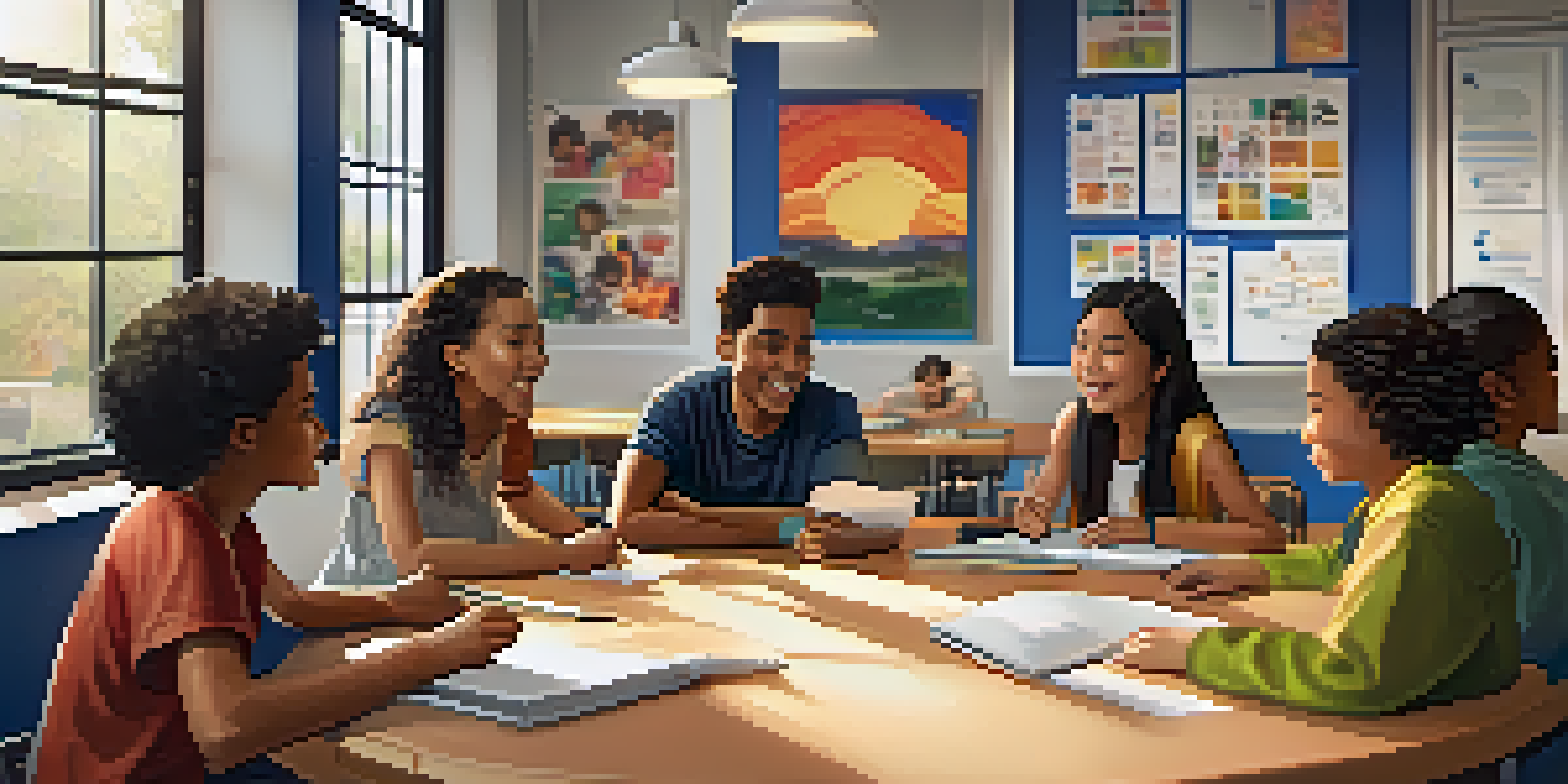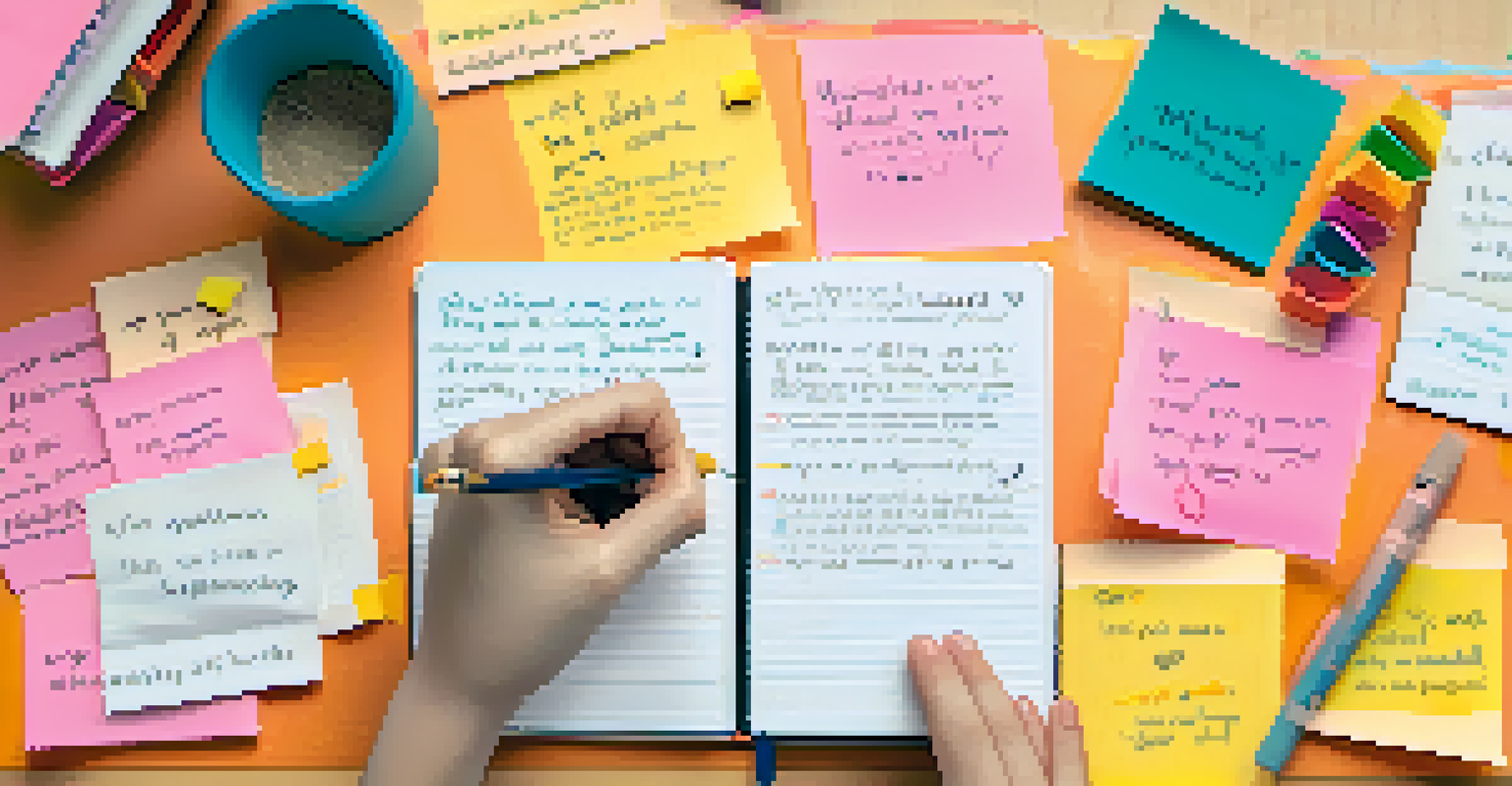Cognitive Behavioral Techniques for Enhancing Group Work in Class

Understanding Cognitive Behavioral Techniques in Education
Cognitive Behavioral Techniques (CBT) are strategies that focus on changing unhelpful thoughts and behaviors. In an educational context, these techniques can help students work more effectively in groups by promoting positive interactions and reducing negative feelings. By understanding the core principles of CBT, educators can facilitate a more collaborative learning environment.
The greatest weapon against stress is our ability to choose one thought over another.
For example, CBT encourages students to recognize and challenge negative thoughts that may arise during group tasks, such as fear of judgment or feelings of inadequacy. This self-awareness can lead to more open communication and a willingness to share ideas. Ultimately, embedding these techniques into group work fosters not just academic success but also emotional resilience among students.
Additionally, incorporating CBT into group dynamics helps in cultivating empathy and understanding. When students learn to view situations from different perspectives, they become more supportive peers. This shift significantly enhances the overall group experience, making learning more enjoyable and effective.
Setting Clear Goals for Group Work
One of the first steps in enhancing group work through CBT is setting clear, achievable goals. When students know what they are working towards, it helps reduce anxiety and increases motivation. These goals can be academic, like completing a project, or interpersonal, such as improving communication skills.

To illustrate, consider a group tasked with creating a presentation. If they set specific targets, like dividing sections among members and agreeing on deadlines, it helps everyone stay focused. This clarity transforms potential chaos into structured collaboration, ensuring that all voices are heard.
Enhancing Group Work through CBT
Cognitive Behavioral Techniques help students manage thoughts and foster positive interactions in group settings.
Moreover, establishing group norms or guidelines can be beneficial. By collectively agreeing on how to communicate and resolve conflicts, students feel more secure and accountable. This creates a positive atmosphere that encourages participation and enhances group dynamics.
Encouraging Positive Self-Talk in Group Settings
Positive self-talk is a powerful tool that can significantly influence group work. When students learn to replace negative thoughts with positive affirmations, they become more confident and engaged participants. This shift in mindset can lead to a more productive group environment.
Alone we can do so little; together we can do so much.
For instance, if a student thinks, 'I can't contribute anything valuable,' they may hesitate to share their ideas. However, encouraging them to reframe that thought to, 'My perspective is unique and valuable,' can empower them to speak up. This change not only benefits the individual but also enriches the group's overall output.
Teachers can facilitate this process by modeling positive self-talk and providing examples of constructive feedback. When students hear affirmations from peers and educators alike, it reinforces their self-worth. This supportive atmosphere fosters collaboration and innovation.
Developing Emotional Regulation Skills within Groups
Emotional regulation is crucial in group work, as it helps students manage feelings that may arise during collaborative tasks. Techniques such as mindfulness can be introduced to help students stay focused and calm, even in challenging situations. This awareness can lead to healthier interactions among group members.
Imagine a scenario where a heated debate arises during a discussion. A student who has practiced emotional regulation might take a moment to breathe and collect their thoughts, rather than reacting impulsively. This small pause can prevent misunderstandings and keep the conversation productive.
Setting Clear Goals Matters
Establishing clear, achievable goals reduces anxiety and boosts motivation, leading to more effective collaboration.
Educators can incorporate activities that promote emotional awareness, such as reflection journals or group check-ins. These practices help students articulate their feelings and listen to others, enhancing empathy and compassion within the group. Ultimately, fostering emotional regulation contributes to a more harmonious and effective group work experience.
Using Feedback to Enhance Group Dynamics
Feedback plays a pivotal role in improving group work and implementing CBT techniques. Constructive feedback helps students understand their strengths and areas for improvement, fostering a growth mindset. This encourages them to view challenges as opportunities rather than obstacles.
For example, after completing a group project, providing specific feedback—like praising collaboration while suggesting clearer communication—can guide future efforts. This process not only enhances individual performance but also strengthens group cohesion.
Moreover, creating a feedback loop where peers can share thoughts on each other's contributions can promote accountability and reflection. When students feel safe to give and receive feedback, it cultivates a culture of trust and respect, essential components of successful group work.
Building Trust and Respect Among Group Members
Trust and respect are foundational elements of effective group work. When students feel valued and understood, they are more likely to share ideas and collaborate openly. Building this trust can be achieved through team-building activities and open dialogues.
An example might involve icebreaker games that encourage students to share fun facts about themselves. These activities help break down barriers and foster connections, making it easier for students to work together. As trust grows, so does the willingness to take risks and contribute.
Trust and Respect Fuel Collaboration
Building trust and respect among group members enhances communication and encourages open idea sharing.
Additionally, promoting a culture of respect—where every opinion is valued—can significantly enhance group dynamics. When students practice active listening and acknowledge each other's contributions, it creates a supportive environment that enhances collaboration and innovation.
Celebrating Successes and Learning from Challenges
Celebrating successes, both big and small, is an essential part of fostering a positive group work experience. When students acknowledge their achievements together, it reinforces their sense of belonging and motivation. These celebrations can be simple, like a class shout-out or sharing positive reflections.
On the flip side, it's equally important to learn from challenges. When a group faces difficulties, discussing those experiences can lead to valuable insights. By analyzing what went wrong and brainstorming solutions together, students develop resilience and problem-solving skills.

Encouraging this reflective practice not only strengthens group bonds but also prepares students for future collaborative endeavors. By balancing recognition of achievements with constructive discussions about challenges, groups can continuously improve and thrive.